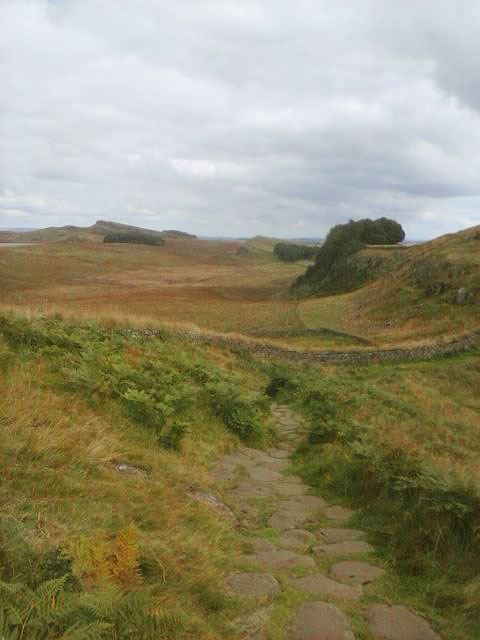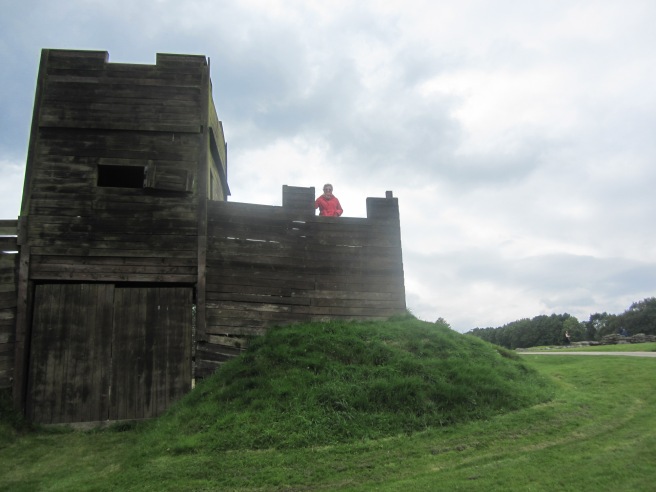
I didn’t know how to start talking about the wall-side of my Northumberland trip, but linnet has given me a clue: “my first impressions of seeing the wall”. Therefore here it is, “the wall and I”.
I’ve always longed to visit the wall. When I was less informed about it I thought that it was placed already in Scotland, not in England (yes, yes, I know… ignorance is something really annoying). Blame it on the movies and tv, I guess. By the way, once the wall is in the “seen dream destinations” list, Scotland, and specially the Highlands, heads now the top-three list “things to see before I die”. Being the other two Australia and the Polynesian Islands (to feel a little bit like Capt. Cook) chances are that Scotland will pass to the “done” column sooner than the other two. The problem is that there are still so many things I want to see near the wall…
As I wrote in the previous post about this trip, I already knew what I expected to see. The current remains of the wall are definitely less impressive of what it once was; this gif I have done mixing my above pic with an still of the film “The Eagle” illustrates the difference.
Although the fort of Vindolanda was not placed besides the wall as Housesteads (Vercovicium), but a few miles away, archeologists have rebuilt two fragments of how the wall looked like, one in stone and the other in timber; the wall in the east and west was built mostly with wood, as the appropriate stone was more difficult to find.


Considering that the wall crossed Britain from Newcastle to Carlisle, even if part of it was made with timber, we are talking of a lot of “lost stones”. They have been used in the centuries to build castles and churches and, should not be for the work and devotion of devoted archeologists most of the wall should be lost now. In the museums of the forts I have visited there is a special section dedicated to this people, the Wall Faces.
During the crisis of the coal mines which left many of the inhabitants of Haltwhistle unemployed, a businessman proposed to create a company (the Roman Stone Ltd) that would quarry what remained of the wall, but fortunately such an action was stopped by the petition of antiquarians, academics and public figures such as Rudyard Kipling. Other Roman archeological treasures have not been so lucky, as the Meta Sudans here in Rome. Their remains stood until almost mid thirties, when they were demolished by order of Mussolini.

Should someone be interested to learn more about the wall I suggest you to read “The Wall – Rome’s Greatest Frontier” by Alistair Moffat edited by Birlinn books. I bought it in Vindolanda’s Museum; I realised on arriving to Rome that there was a mistake in the binding of the book and that the first block of pages was repeated and some missing. I wrote the publisher and this week I have receive a very kind e-mail informing me that they will send me a brand new book, a hardback edition (I bought the paperback). Another example of Northern-Scottish (Birlinn Books is in Edinburgh) kindness; I just asked them a pdf file with the missing pages, not the whole book!
As usual, I am rambling without writing what I wanted: my impressions of the wall. Even if I wanted to visit the wall badly, I travelled not as prepared as I thought. The first night in the B&B, while sipping my mug of Earl Grey (by the way… I saw in Newcastle the monument to the Earl Grey in person) and reading the tourist depliants we had in our room, I realised that if I visited only Vindolanda and the Roman Army Museum in Carvoran I would miss the classical-iconical wall image, the view from Housesteads crags (first picture of this post). Therefore we devoted the second whole day we had at disposal in the north to Housesteads.

The site forms part of the English Heritage. As we are members of the Fondo Ambiente Italiano we can visit English Heritage sites for free; needless to say that I felt moved and proud. While arriving to destination with the bus (number AD122, the year Hadrian begun the construction of the wall) I felt already thrilled when recognising the shape of the hills, or the famous Sycamore Gap.

When climbing the hill leading to Housesteads I felt really happy, and I longed so badly to arrive to the top and see the landscape that I was about to run.

I entered through the south gate, pretended to pay attention to the remains of the commanders’ house on the left and hurried to the top, because I was anxious to arrive to the northern gate, where you can see this.

I finally had it in front of me: the immensity of the North, the wild land of Brigantes and Picts and, on my right, the second most iconic image of the wall, the Knag Burn gateway.

More pictures, comments and impressions in another post. Stay tuned!


You are SO into this, you could almost get me to be interested in the Romans. Keep going.
“almost” 😀 😀 😀
Thank you for your kind comment.
Lovely. Glorious lanscape with rolling hills, big wide skies, the lines of the stone walls criss-crossing the fields. I am a total nerd for all of this, and seeing your pictures I now want to go there more than ever. So thanks for the first part of the journey.
PS: I always love seeing pics of my fellow sisters-in-RA. Nice rain proof 😀
Guylty thank you for expressing in words what that landscape inspires me. 🙂 I strongly recommend you to make that trip, I will return (hope soon)
Yep, a slightly large size sister-in-RA 😀 About the rain proof: seen from afar, without glasses and after drinking two pints of beer may pass for a Belstaff 😀
Large size? Where was she? I didn’t see her! And that mac definitely had the Belstaff contours. Well chosen! 😀
I bought if for 10 euros to an African street peddler in Spain 😀
Best bargain ever!!! But: Did it withstand British Isle style rain?
Remember, it didn’t rain 😀 And we had raincoats that would stand the water.
Yes, British Isle style rain = horizontal. 😀 The first thing that caught my attention in London: when it rains, umbrellas are useless as water arrive from everywhere. 😀
LOL. Sounds like home (Ireland).
Loving this! Especially the cool gif of the ancient and modern wall. Those huge open countrysides of Northumberland have me thinking of Hotspur as well as the Romans 🙂 This was in the summer and you had to wear a coat, so I can imagine what the ancient Romans made of it. They must have thought it was the frozen land of the Hyperboreans. (Very stylish coat BTW. I always buy a red coat, if I can.)
Thank you linnet. When I returned I checked the wall-scenes of “The Eagle” and I was thunderstruck on recognising the landscape (particularly the trees besides the wall).
Yes, Hotspur! When I arrived to the top of the hill I had to use also a wool cap that I bought the day before in Vindolanda, the breeze was cool! Soldiers destined to the wall were not from the Mediterranean, one of the cohorts that occupied for several years the fort were from the north of Belgium. Nevertheless as you say… it was August! I can’t imagine what it’s like up there end January.
Thank you! I buy if I can coloured outfits, I have a winter read coat also 🙂
I am laughing because they sell wool caps there in August 🙂
After lunch wind raised in Vindolanda and my ears began to cry for help, so I went again to the gift shop and bought the cap. It was also very useful the day after even if the sun shined. 😀